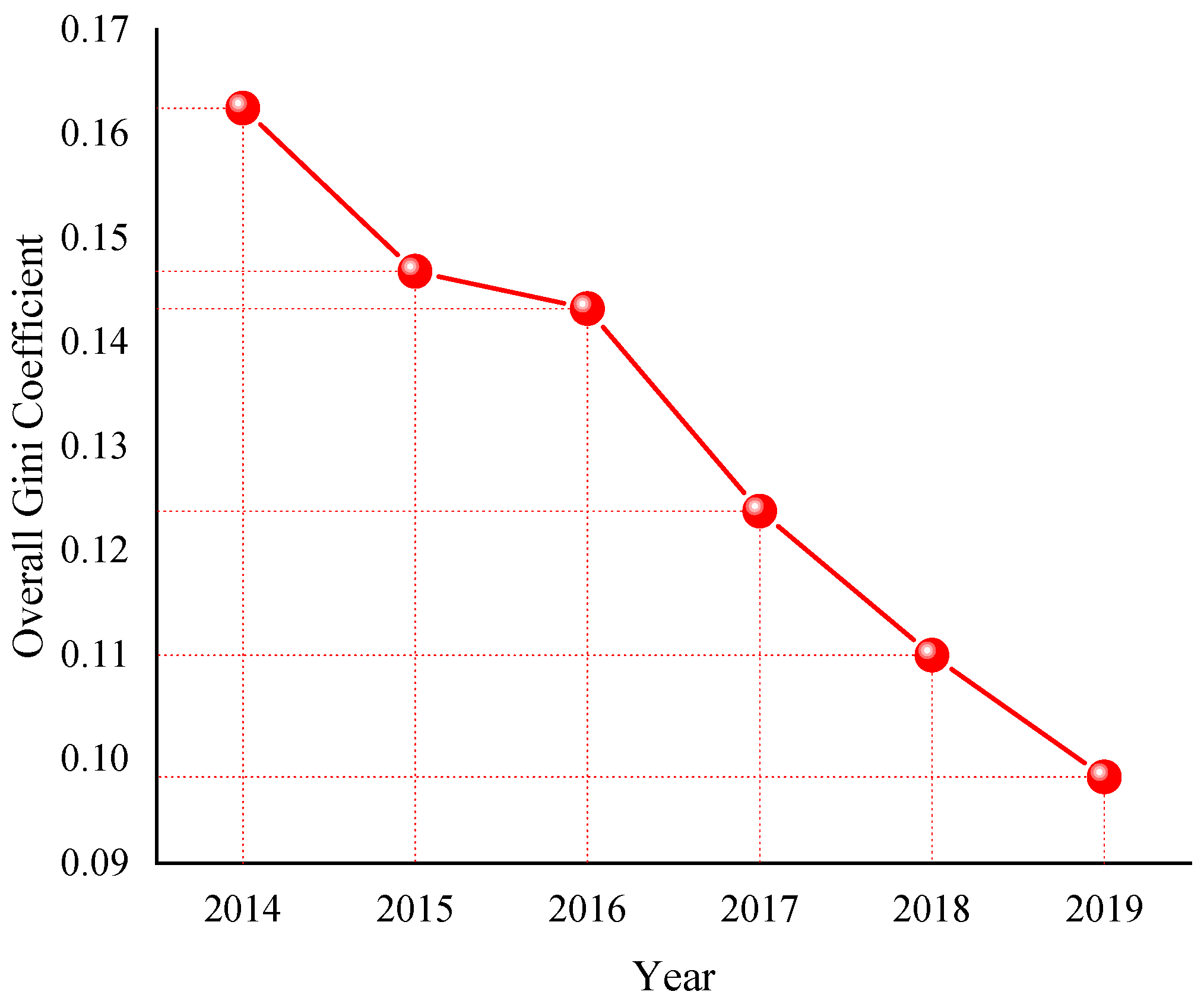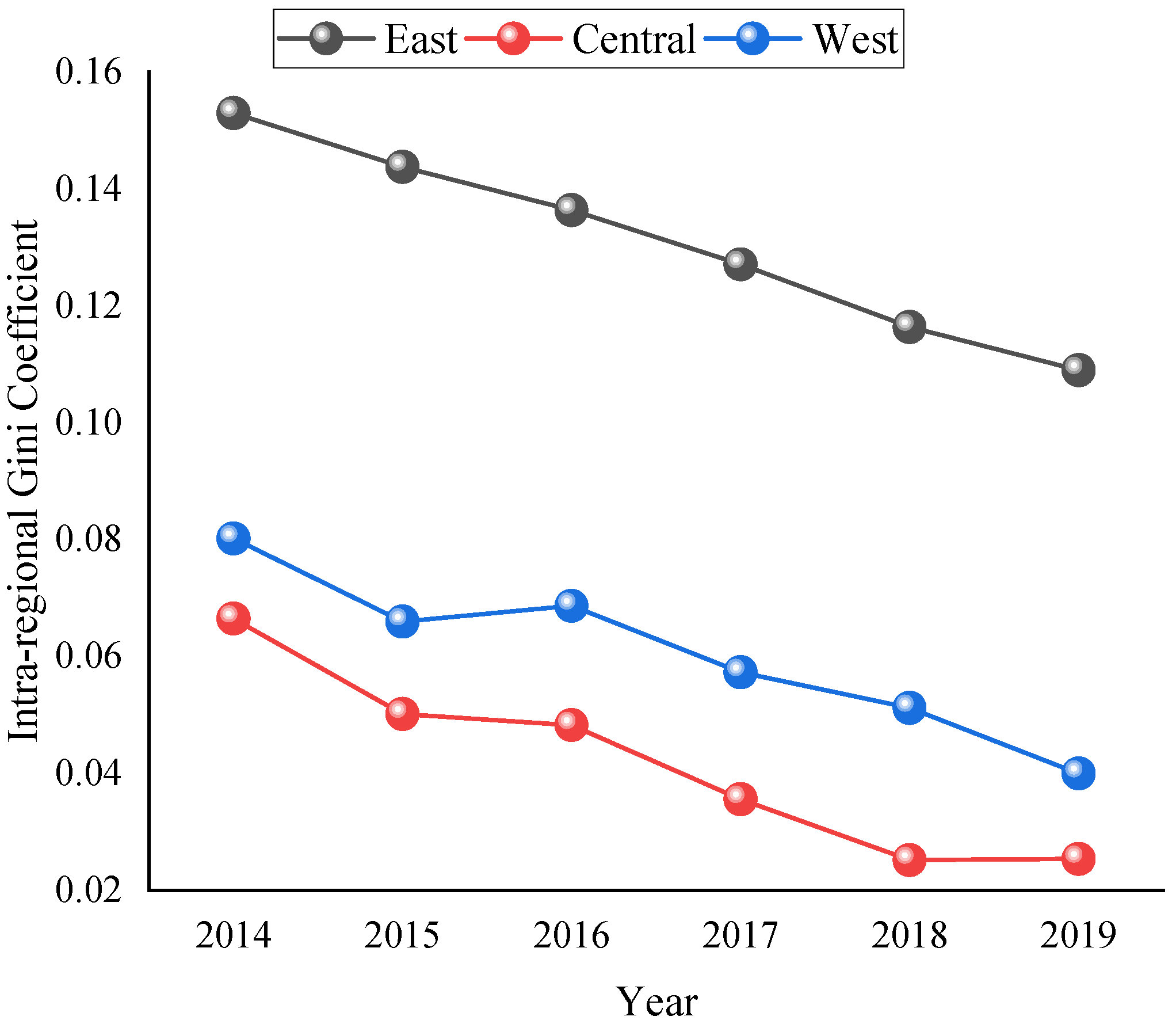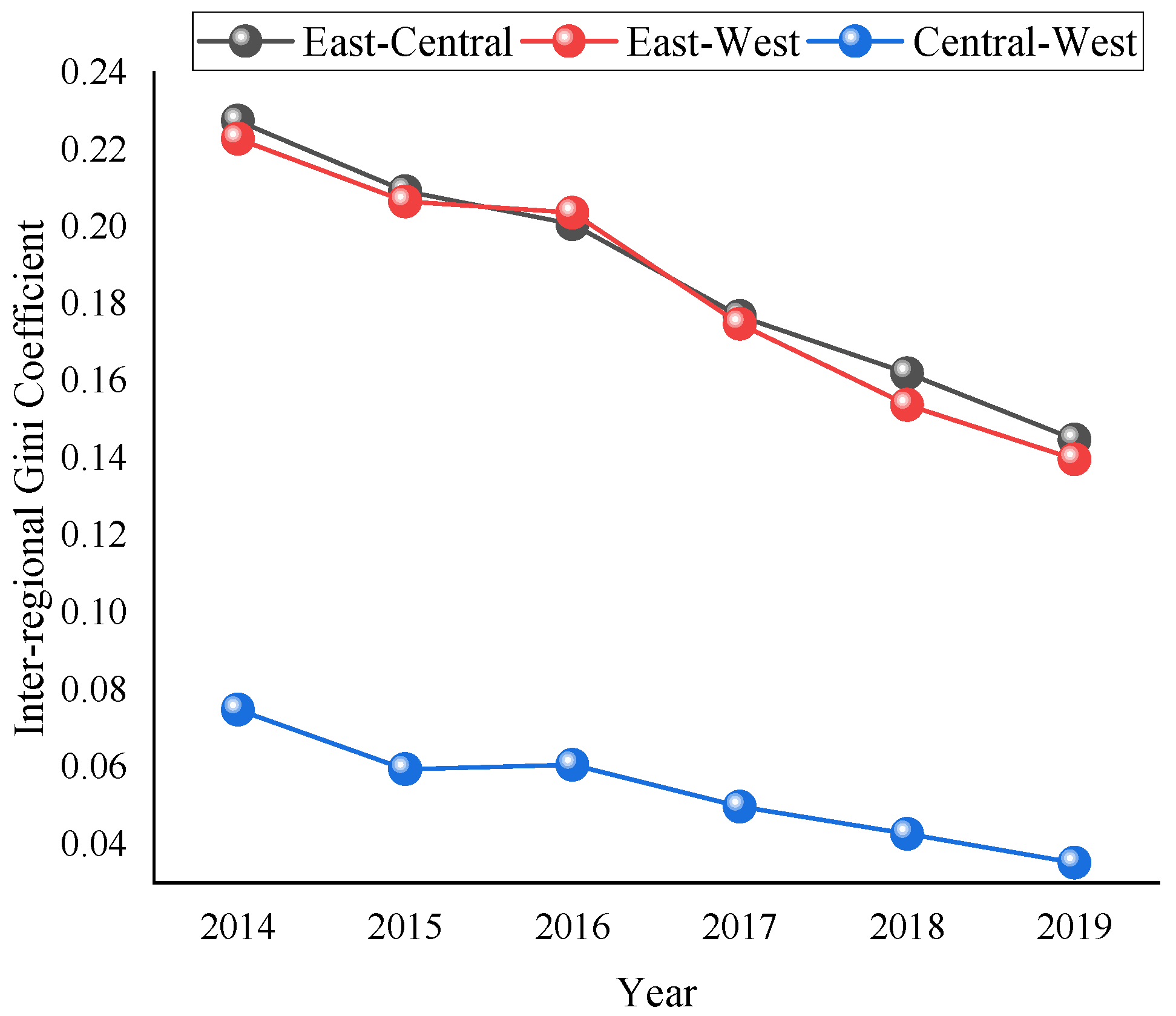Dynamic Coupling Trajectory and Spatial-Temporal Characteristics of High-Quality Economic Development and the Digital Economy
Abstract
:1. Introduction
2. Literature Review
3. Data Sources and Construction of Indication System (IS)
3.1. Measuring the Level of Development of Digital Economy
3.2. Measuring the Quality of Economic Development
4. Dynamic Coupling
4.1. Model of Coupling Coordination Degree
4.2. Dynamic Trajectory of Coupling Coordination Based on the Markov Chain
4.3. Measuring the Coupling Coordination
4.4. Probabilistic Transformation Trajectory of the Coupling Coordination Degree
5. Spatial and Temporal Characteristics
5.1. Dagum Gini Coefficients and Their Decomposition
5.2. Analysis of Regional Differences in Coupling Coordination and Their Sources
5.2.1. Overall Differences in Coupling Coordination
5.2.2. Intra-Regional Variations in Coupling Coordination Degrees
5.2.3. Inter-Regional Variations in Coupling Coordination
5.2.4. Sources of Variation in Coupling Coordination and Their Contributions
6. Conclusions
Author Contributions
Funding
Institutional Review Board Statement
Informed Consent Statement
Data Availability Statement
Conflicts of Interest
References
- Liu, W.; Xin, F. China Remains in an Important Period of Strategic Opportunities: Transcending Potential Economic Growth. Manag. World 2019, 35, 13–23. [Google Scholar]
- Zhou, Q.X.; He, A.P. Digital economy empowers high-quality development in the Yellow River Basin. Econ. Probl. 2020, 8–17. [Google Scholar] [CrossRef]
- Jing, W.J.; Sun, B.W. Digital economy promotes high-quality economic development: A theoretical analysis framework. Economist 2019, 2, 66–73. [Google Scholar] [CrossRef]
- Ding, Z. Research on the mechanism of digital economy driving high-quality economic development: A theoretical analysis framework. Mod. Econ. Res. 2020, 1, 85–92. [Google Scholar] [CrossRef]
- Ma, Q.; Tariq, M.; Mahmood, H.; Khan, Z. The nexus between digital economy and carbon dioxide emissions in China: The moderating role of investments in research and development. Technol. Soc. 2022, 68, 101910. [Google Scholar] [CrossRef]
- Zhang, T.; Jiang, F.X.; Wei, Z.T. Can the digital economy become a new driving force for China’s high-quality economic development? Inq. Econ. Issues 2021, 25–39. Available online: https://kns.cnki.net/kcms/detail/detail.aspx?FileName=JJTL202001011&DbName=CJFQ2020 (accessed on 28 February 2022).
- Zhang, R.; Wang, G.Y.; Sun, X.L. Fiscal Decentralization, Industrial Structure and High-quality Development of the Yellow River Basin. Econ. Probl. 2020, 1–11. [Google Scholar] [CrossRef]
- Xu, X.H. Digital economy and high-quality economic development: Empirical evidence based on the perspective of industrial structure upgrading. Stat. Decis. 2022, 38, 95–99. [Google Scholar]
- Yang, W.P. Digital economy for high-quality development: Production efficiency improvement and consumption expansion. J. Shanghai Univ. Financ. Econ. 2022, 24, 48–60. [Google Scholar]
- Li, K.; Kim, D.J.; Lang, K.R.; Kauffman, R.J.; Naldi, M. How should we understand the digital economy in Asia? Critical assessment and research agenda. Electr. Commer. Res. Appl. 2020, 44, 101004. [Google Scholar] [CrossRef]
- Ali, M.A.; Hoque, M.R.; Alam, K. An empirical investigation of the relationship between e-government development and the digital economy: The case of Asian countries. J. Knowl. Manag. 2018, 22, 1176–1200. [Google Scholar] [CrossRef]
- Jia, H.W.; Zhang, W.T.; Pan, Y.Z. Science and technology innovation, industrial structure upgrading, and high-quality economic development. Shanghai J. Econ. 2021, 50–60. [Google Scholar] [CrossRef]
- Noseleit, F. Entrepreneurship, Structural Change, and Economic Growth; ERSA Conference Papers; European Regional Science Association: Louvain-la-Neuve, Belgium, 2011. [Google Scholar] [CrossRef] [Green Version]
- Yang, D.; Zhang, Y.T.; Hu, D.F. Research on the Paths of Digital Economy Empowering High-quality Development: Based on the Configuration Analysis of the Integrated Central Cities in the Yangtze River Delta. East China Econ. Manag. 2021, 35, 39–47. [Google Scholar]
- Zhang, X.; Wan, G.H.; Zhang, J.J.; He, Z.Y. Digital Economy, Financial Inclusion, and Inclusive Growth. Econ. Res. J. 2019, 54, 71–86. [Google Scholar]
- Han, W.L. Political economy analysis of the digital economy empowering high-quality economic development. J. Grad Sch. Chin. Acad Soc. Sci. 2021, 98–108. Available online: https://kns.cnki.net/kcms/detail/detail.aspx?FileName=ZSKY202102011&DbName=CJFQ2021 (accessed on 28 February 2022).
- Zhang, H.; Liu, Z.; Wang, S.X. Exploration of the path of high-quality development of China’s economy in the context of digital economy. J. Commer. Econ. 2019, 183–186. Available online: https://kns.cnki.net/kcms/detail/detail.aspx?FileName=SYJJ201923049&DbName=CJFQ2019 (accessed on 28 February 2022).
- Wang, J.; Chen, G.F. “Internet Plus”, Factor Allocation and High-Quality Development of Manufacturing Industry. Tech. Econ. 2020, 39, 61–72. [Google Scholar]
- Fan, H.J.; Wu, T. Can digitalization promote economic growth and high-quality development: Empirical evidence from provincial panel data in China. J. Manag. 2021, 34, 36–53. [Google Scholar]
- Guo, J.T.; Luo, P.L. Can Internet promote total factor productivity in China? Manag. World 2016, 34–49. [Google Scholar] [CrossRef]
- Liu, Z.B.; Ling, Y.F. Structural Transformation, Total Factor Productivity, and High-quality Development. Manag. World 2020, 36, 15–29. [Google Scholar]
- Min, L.L.; Xu, Z.Z. Digital economy, innovation performance, and high quality economic development: Empirical evidence based on Chinese cities. Stat. Decis. 2022, 11–15. [Google Scholar] [CrossRef]
- Liu, X.X.; Hui, N. Internet, technological innovation and high-quality development of manufacturing industry: Analysis of heterogeneous effects based on innovation models. Inq. Econ. Issues 2021, 143–155. Available online: https://kns.cnki.net/kcms/detail/detail.aspx?FileName=JJWS202109013&DbName=DKFX2021 (accessed on 28 February 2022).
- Liu, S.C. Targeting Path and Policy Supply for the High-Quality Development of China’s Digital Economy. Economist 2019, 52–61. [Google Scholar] [CrossRef]
- Wang, K.K.; Wu, G.B.; Zhang, G.J. Has the Development of the Digital Economy Improved Production Efficiency? Economist 2020, 10, 24–34. [Google Scholar] [CrossRef]
- Zhu, W.J.; Chen, J.J. The spatial analysis of digital economy and urban development: A case study in Hangzhou, China. Cities 2022, 123, 103563. [Google Scholar] [CrossRef]
- Lu, Y.X.; Fang, X.M.; Zhang, Q. Digital Economy, Spatial Spillover and High-Quality Development of Urban Economy. Econ. Surv. 2021, 38, 21–31. [Google Scholar]
- Yan, Y.; Zhang, W. Dynamic evolution of regional disparity and distribution of high-quality urban development in the Yangtze River Economic Belt. Yangtze River Basin Resourc. Environ. 2022, 31, 259–272. [Google Scholar]
- Liu, Z.; Wakasi, R. Regional differences and dynamic evolution of the distribution of high-quality agricultural development in China. Quant. Econ. Tech. Econ. Res. 2021, 38, 28–44. [Google Scholar]
- Shi, B.; He, L.; Zhang, W.M. Dynamic evolution and trend prediction of high-quality development of urban economy in the Yellow River Basin. Econ. Issues 2021, 1–8. [Google Scholar] [CrossRef]
- Zhao, T.; Zhang, Z.; Liang, S.K. Digital economy, entrepreneurial activity and high-quality development: Empirical evidence from Chinese cities. Manag. World 2020, 36, 65–76. [Google Scholar]
- Huang, Q.H.; Yu, Y.Z.; Zhang, S.J. Internet development and manufacturing productivity improvement: Intrinsic mechanism and China’s experience. China Industr. Econ. 2019, 5–23. [Google Scholar] [CrossRef]
- Guo, F.; Wang, J.Y.; Wang, F.; Kong, T.; Zhang, X.; Cheng, Z.Y. Measuring China’s digital financial inclusion: Index compilation and spatial characteristics. China Econ. Quart. 2020, 19, 1401–1418. [Google Scholar]
- Wang, S.J.; Gu, S. Research on the impact of S&T finance on the high-quality development of Chinese economy—Theoretical analysis and empirical test. Economist 2021, 81–91. [Google Scholar] [CrossRef]
- Yang, Y.W.; Zhang, P. Logic, measurement and governance in China’s high quality economic development. Econ. Res. J. 2021, 56, 26–42. [Google Scholar]
- Ma, R.; Luo, H.; Wang, H.W.; Wang, T.C. Study of evaluating high-quality economic development in Chinese regions. China Soft Sci. 2019, 7, 60–67. [Google Scholar]
- Wei, M.; Li, S.H. Study on the measurement of economic high-quality development level in China in the new era. J. Quant. Tech. Econ. 2018, 35, 3–20. [Google Scholar]
- Liu, Y.C.; Shen, W.K.; Liu, L.L. A study on the dynamic coupling coordination degree between science and technology finance and advanced manufacturing innovation development. Econ. Probl. 2021, 36–43. [Google Scholar] [CrossRef]
- Hong, M.Y.; He, Y.F.; Song, H.F. Spatial and temporal coupling of agricultural land transfer and farmers’ income in China and spatial effects. J. Nat. Resour. 2021, 36, 3084–3098. [Google Scholar] [CrossRef]
- Quah, D.T. Twin peaks: Growth and convergence in models of distribution dynamics. Econ. J. 1996, 106, 1045–1055. [Google Scholar] [CrossRef] [Green Version]
- Dagum, C. A new approach to the decomposition of the Gini income inequality ratio. Empir. Econ. 1997, 22, 515–531. [Google Scholar] [CrossRef]
- Deng, R.R.; Zhang, A.X.; Chen, M. Spatial and temporal evolution of the coupling degree of digital economy development and economic growth quality and the driving factors--numerical measurement and empirical analysis. J. Nanjing Univ. Financ. Econ. 2021, 5, 33–43. [Google Scholar]




| Systems | Subsystems | Specific Indicators | Direction |
|---|---|---|---|
| Digital Economy Development | Internet penetration | Mobile internet penetration rate | + |
| Cell phone penetration | Cell phone penetration rate (units per 100 people) | + | |
| Internet Practitioners | Percentage of computer and software employees | + | |
| Internet Output | Total telecom business per capita (RMB/person) | + | |
| Digital Financial Development | Digital Financial Inclusion Index | + | |
| High-Quality Economic Development | Innovation | Percentage of fiscal expenditure on science and technology | + |
| Percentage of science and technology personnel | + | ||
| Number of patents granted per 10,000 people | + | ||
| Technology Market Turnover | + | ||
| Coordination | Urban Registered Unemployment Rate | − | |
| Ratio of bank financial deposits to loans | − | ||
| Ratio of secondary and tertiary industries | + | ||
| Ratio of disposable income of urban and rural residents | − | ||
| Ratio of urban and rural residents’ consumption expenditure | − | ||
| Green | Investment in industrial pollution control | − | |
| Energy consumption per unit of GDP | − | ||
| Greening coverage rate | + | ||
| Openness | Import and export volume/GDP | + | |
| Amount of foreign investment/GDP | + | ||
| Number of foreign enterprises/number of enterprise units | + | ||
| Sharing | Total library collections per 10,000 people | + | |
| Number of museums per 10,000 people | + | ||
| Number of beds in medical institutions per 10,000 people | + | ||
| Urbanization rate | + | ||
| GDP per capita | + |
| Type of Development | Development Stage | |
|---|---|---|
| Antagonistic early stage | Antagonistic stage | |
| Middle antagonism | ||
| End of antagonism | ||
| Pre-running-in transition | ||
| Mid-running-in transition | running-in stage | |
| Late running-in transition | ||
| Low level of coordinated development | Coordination stage | |
| Medium level of coordinated development | ||
| High level of coordinated development |
| Region | 2014 | 2015 | 2016 | 2017 | 2018 | 2019 |
|---|---|---|---|---|---|---|
| Shanghai | 0.6307 | 0.6578 | 0.6530 | 0.7020 | 0.7705 | 0.8163 |
| Beijing | 0.7509 | 0.7832 | 0.7768 | 0.8282 | 0.8884 | 0.9440 |
| Tianjin | 0.4071 | 0.4516 | 0.4585 | 0.5179 | 0.6026 | 0.6564 |
| Shandong | 0.3270 | 0.3624 | 0.3719 | 0.4189 | 0.4812 | 0.5355 |
| Guangdong | 0.4824 | 0.5131 | 0.5102 | 0.5755 | 0.6657 | 0.7164 |
| Jiangsu | 0.4528 | 0.4851 | 0.4771 | 0.5288 | 0.6077 | 0.6676 |
| Hebei | 0.2680 | 0.2958 | 0.3123 | 0.3541 | 0.4164 | 0.4702 |
| Zhejiang | 0.4783 | 0.5155 | 0.5094 | 0.5620 | 0.6386 | 0.7028 |
| Hainan | 0.3868 | 0.4146 | 0.4237 | 0.4699 | 0.5441 | 0.5937 |
| Fujian | 0.3955 | 0.4270 | 0.4166 | 0.4608 | 0.5309 | 0.5760 |
| Liaoning | 0.3811 | 0.4060 | 0.4088 | 0.4606 | 0.5107 | 0.5455 |
| The east region | 0.4510 | 0.4829 | 0.4835 | 0.5344 | 0.6052 | 0.6568 |
| Jilin | 0.3349 | 0.3541 | 0.3582 | 0.4076 | 0.4551 | 0.5053 |
| Anhui | 0.2761 | 0.3230 | 0.3337 | 0.3814 | 0.4531 | 0.5160 |
| Shanxi | 0.2959 | 0.3157 | 0.3166 | 0.3637 | 0.4241 | 0.4707 |
| Jiangxi | 0.2673 | 0.3014 | 0.2954 | 0.3564 | 0.4242 | 0.4807 |
| Henan | 0.2390 | 0.2833 | 0.2948 | 0.3569 | 0.4249 | 0.4770 |
| Hubei | 0.3240 | 0.3641 | 0.3661 | 0.4164 | 0.4862 | 0.5467 |
| Hunan | 0.2475 | 0.2830 | 0.2908 | 0.3472 | 0.4206 | 0.4816 |
| Heilongjiang | 0.3180 | 0.3344 | 0.3427 | 0.3908 | 0.4332 | 0.4794 |
| The central region | 0.2878 | 0.3199 | 0.3248 | 0.3776 | 0.4402 | 0.4947 |
| Yunnan | 0.2445 | 0.2801 | 0.2816 | 0.3452 | 0.4054 | 0.4636 |
| Inner Mongolia | 0.3299 | 0.3481 | 0.3495 | 0.3967 | 0.4559 | 0.5012 |
| Sichuan | 0.3204 | 0.3590 | 0.3608 | 0.4036 | 0.4767 | 0.5256 |
| Ningxia | 0.2979 | 0.3286 | 0.3339 | 0.4362 | 0.4985 | 0.5451 |
| Guangxi | 0.2486 | 0.2859 | 0.2825 | 0.3401 | 0.4151 | 0.4635 |
| Xinjiang | 0.2898 | 0.3112 | 0.3036 | 0.3321 | 0.3945 | 0.4591 |
| Gansu | 0.2639 | 0.2989 | 0.2958 | 0.3592 | 0.4292 | 0.4834 |
| Guizhou | 0.2255 | 0.2670 | 0.2725 | 0.3422 | 0.4209 | 0.4822 |
| Chongqing | 0.3261 | 0.3619 | 0.3636 | 0.4135 | 0.4884 | 0.5360 |
| Shaanxi | 0.3697 | 0.3923 | 0.4013 | 0.4458 | 0.5275 | 0.5724 |
| Qinghai | 0.2949 | 0.3173 | 0.3150 | 0.3747 | 0.4481 | 0.4921 |
| The west region | 0.2919 | 0.3228 | 0.3237 | 0.3809 | 0.4509 | 0.5022 |
| Nationwide | 0.3491 | 0.3807 | 0.3826 | 0.4363 | 0.5046 | 0.5569 |
| C.V | 0.3342 | 0.3047 | 0.2962 | 0.2576 | 0.2267 | 0.2052 |
| Eastern Region | |||||||
| 14–17 | 17–19 | ||||||
| 0.00% | 100.00% | 0.00% | 100.00% | 0.00% | 0.00% | ||
| 0.00% | 100.00% | 0.00% | 0.00% | 55.56% | 44.44% | ||
| 0.00% | 0.00% | 100.00% | 0.00% | 0.00% | 100.00% | ||
| Central Region | |||||||
| 14–17 | 17–19 | ||||||
| 0.00% | 100.00% | 0.00% | 100.00% | 0.00% | 0.00% | ||
| 0.00% | 100.00% | 0.00% | 0.00% | 100.00% | 0.00% | ||
| 0.00% | 0.00% | 100.00% | 0.00% | 0.00% | 100.00% | ||
| Western Region | |||||||
| 14–17 | 17–19 | ||||||
| 0.00% | 100.00% | 0.00% | 100.00% | 0.00% | 0.00% | ||
| 0.00% | 100.00% | 0.00% | 0.00% | 100.00% | 0.00% | ||
| 0.00% | 0.00% | 100.00% | 0.00% | 0.00% | 100.00% | ||
| Year | Overall Variation G | Intra-Regional Variation | Inter-Regional Variation | ||||
|---|---|---|---|---|---|---|---|
| East | Central | West | East-Central | East-West | Central-West | ||
| 2014 | 0.1625 | 0.1530 | 0.0665 | 0.0802 | 0.2275 | 0.2229 | 0.0749 |
| 2015 | 0.1468 | 0.1438 | 0.0502 | 0.0660 | 0.2093 | 0.2066 | 0.0595 |
| 2016 | 0.1432 | 0.1364 | 0.0483 | 0.0687 | 0.2007 | 0.2037 | 0.0606 |
| 2017 | 0.1238 | 0.1271 | 0.0356 | 0.0573 | 0.1769 | 0.1749 | 0.0498 |
| 2018 | 0.1100 | 0.1164 | 0.0252 | 0.0512 | 0.1621 | 0.1539 | 0.0427 |
| 2019 | 0.0983 | 0.1090 | 0.0254 | 0.0400 | 0.1449 | 0.1398 | 0.0352 |
| Mean | 0.1308 | 0.1309 | 0.0419 | 0.0606 | 0.1869 | 0.1836 | 0.0538 |
| Standard deviation | 0.0222 | 0.0152 | 0.0148 | 0.0129 | 0.0311 | 0.0327 | 0.0142 |
| Decline | 0.0642 | 0.0439 | 0.0411 | 0.0402 | 0.0826 | 0.0832 | 0.0397 |
| Rate | 1.07% | 0.73% | 0.68% | 0.67% | 1.38% | 1.39% | 0.66% |
| Year | Contribution | Contribution Rate | ||||
|---|---|---|---|---|---|---|
| Intra-Regional Variation | Inter-Regional Variation | Hypervariable Density | Intra-Regional Variation | Inter-Regional Variation | Hypervariable Density | |
| 2014 | 0.0395 | 0.1081 | 0.0149 | 24.30% | 66.52% | 9.18% |
| 2015 | 0.0351 | 0.0992 | 0.0126 | 23.88% | 67.55% | 8.57% |
| 2016 | 0.0339 | 0.0970 | 0.0123 | 23.67% | 67.74% | 8.58% |
| 2017 | 0.0298 | 0.0832 | 0.0107 | 24.11% | 67.22% | 8.67% |
| 2018 | 0.0265 | 0.0751 | 0.0084 | 24.07% | 68.33% | 7.60% |
| 2019 | 0.0237 | 0.0671 | 0.0075 | 24.15% | 68.26% | 7.59% |
| Mean | 0.0314 | 0.0883 | 0.0111 | 24.03% | 67.60% | 8.36% |
| Standard deviation | 0.0058 | 0.0157 | 0.0028 | 0.22% | 0.68% | 0.64% |
| Decline | 0.0157 | 0.0410 | 0.0075 | 0.14% | −1.74% | 1.60% |
| Rate | 0.26% | 0.68% | 0.12% | 0.02% | −0.29% | 0.27% |
Publisher’s Note: MDPI stays neutral with regard to jurisdictional claims in published maps and institutional affiliations. |
© 2022 by the authors. Licensee MDPI, Basel, Switzerland. This article is an open access article distributed under the terms and conditions of the Creative Commons Attribution (CC BY) license (https://creativecommons.org/licenses/by/4.0/).
Share and Cite
Shen, W.; Xia, W.; Li, S. Dynamic Coupling Trajectory and Spatial-Temporal Characteristics of High-Quality Economic Development and the Digital Economy. Sustainability 2022, 14, 4543. https://doi.org/10.3390/su14084543
Shen W, Xia W, Li S. Dynamic Coupling Trajectory and Spatial-Temporal Characteristics of High-Quality Economic Development and the Digital Economy. Sustainability. 2022; 14(8):4543. https://doi.org/10.3390/su14084543
Chicago/Turabian StyleShen, Weikang, Weiqi Xia, and Sufeng Li. 2022. "Dynamic Coupling Trajectory and Spatial-Temporal Characteristics of High-Quality Economic Development and the Digital Economy" Sustainability 14, no. 8: 4543. https://doi.org/10.3390/su14084543
APA StyleShen, W., Xia, W., & Li, S. (2022). Dynamic Coupling Trajectory and Spatial-Temporal Characteristics of High-Quality Economic Development and the Digital Economy. Sustainability, 14(8), 4543. https://doi.org/10.3390/su14084543






